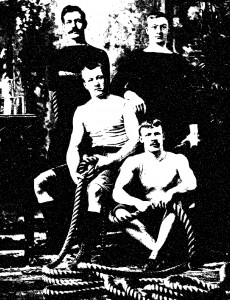Tug-of-War Victory over Harvard, 1887: Was This MIT’s Greatest Unknown Athletic Feat?
-
-
slice.mit.edu
Filed Under
Recommended
With a student body notable for athletes as well as scholars, MIT’s 33 varsity sports provide the most intercollegiate offerings among the country’s Division III schools. The Engineers have won 22 team national championships and produced 34 individual national champions, plus 23 Olympic athletes. Within the last 10 years alone, students accrued 464 All-America honors.

Although it has slipped from collective memory, one of Tech’s arguably most thrilling games occurred in 1887.
“The defeat of Harvard’s tug-of-war team by our four untrained and inexperienced men is the greatest athletic feat which the Institute has ever accomplished,” trumpeted The Tech in March 17, 1887. “…We have scored many triumphs in the same line, but never when it was so entirely unlooked for, and under such unfavorable circumstances.”
A photo of the champion tug-of-war team was published in The Tech's April 28, 1887, issue with this caption: “We take great pleasure in presenting the readers of THE TECH a phototype of our victorious tug-of-war team, which pulled the Harvard University tug-team 2-1/2 inches."
When MIT decided to enter the 1887 meet just two weeks before the event, it took a full week to round up four volunteers for a team. They only managed three hours of practice together, while The Tech reported that Harvard’s team “pass the 16-pound shot for fifteen minutes every afternoon.” In addition, MIT’s team fell below the weight limit and therefore lacked the advantage of having all possible pounds where it really mattered.
This untrained and lightweight MIT team faced an opponent with the formidable reputation of “the champion team among colleges.” Then as now, MIT’s victories over Harvard proved particularly sweet.
Alas, tug-of-war contests were on their way out. In 1891 the MIT Athletic Club joined Harvard and other prominent colleges in dropping tug-of-war from the sports roster. In the following spring, the American Intercollegiate Athletic Association officially replaced tug-of-war with bicycle racing.
While tug-of-war remained an Olympic sport until 1920, college competition peaked in the 1880s. Time magazine wrote in May 27, 1940, “Though few U. S. citizens can remember or believe it, tug-of-war was once the most popular of intercollegiate sports.”







